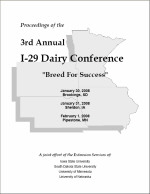



Improving Reproductive Performance on Commercial Dairies
By Neil Michael, DVM MBA, Director of Technical Services, ABS Global, Inc. This article is taken from the published proceedings of the 3rd Annual I-29 Dairy Conference, "Breed For Success". To find out more about this conference click on the link provided below.Introduction
High reproductive success is fundamental to a dairy operation’s sustainability and growth in today’s dairy industry.Over 95% of reproductive outcomes can be attributed to the environment of the cow and related management factors (USDA, 2005) which highlights the need for effective evaluation and monitoring of reproductive performance indicators. This paper will highlight several fundamental opportunities to improve reproductive programs on commercial dairies and the preferred methods of measurement and monitoring their success.
Economics of Reproduction
Regardless of location within the world, improving reproductive efficiency has a significant influence on profitability. A recent review of financial results for US dairies (Genske, Mulder, 2006 figures) revealed milk revenue accounted for 93-95% of farm revenues and replacement animals represented 9-11% of total gross expenses (second only to feed costs), both of which are impacted by pregnancy production. Specifically, improved reproductive efficiency has a positive impact on milk flow (by placing more animals in the efficient and profitable portion of the cycle) and subsequently increase youngstock numbers that fuel herd replacements and overall growth opportunities.
In addition, genetic gain is hastened due to the ability to cull voluntarily (less reproductive culls) and the tendency to utilize higher genetic merit animals when reproductive numbers are good. Current reports (DeVries, et al. ABS Pre-conference proceedings, Reno, NV 2007) estimate each incremental increase in pregnancy rate (PR) percentage point (within a range of 13-20 PR) return an estimated $15-18 per cow per year net of expenses.
Reproductive Measures
Pregnancy rate (PR) is defined as the rate at which eligible animals become pregnant during a specified period (usually 21 days) and is the preferred metric by which reproductive programs are measured. Although the US average PR is estimated to be 13-14%, many herds now consistently achieve 20-25% which gives them a distinct economic advantage over average PR herds.
Conception rate (CR) is represented as the total number of known pregnant animals divided by the total number of inseminated animals with known outcomes. We now see CR on many commercial dairies exceeding 35-40% which is in sharp contrast to the continual decline of fertility of the US cattle population that has been commonly cited in recent years.
Insemination risk (IR) formerly known as heat detection rate is the percent of eligible animals that are detected and inseminated each measured period (usually 21 days). US average IR is estimated to be 35-55% (8) although 60-70% IR is possible when programs, cows, and facilities are optimized and managed correctly.
Other measures such as pregnancy inventory (PI) are utilized by many commercial herds to monitor the number of pregnancies produced each week in relation to required numbers to sustain a constant herd size. Although useful in stable situations, PI has limitations in herds with extreme seasonality or expansion dynamics. The inadequacies of previously popular measures such as days open (DOPN) and calving interval (CI) have been described by others (5) and should not be used to manage reproductive programs proactively.
Reproductive Opportunities and Compliance Measures
Determining whether PR, IR, or CR performance meet the current goals of the dairy is quite simple---the more difficult but valuable component for the dairy management team is identifying a short list of profitable opportunities that the dairy commits to improve. Once a list has been determined, key measures should be identified to allow evaluation and monitoring of the implemented change.
The pregnancy production system is impacted by multiple influencers that must all be managed to consistently produce quality pregnancies (Figure 1). Producers should ensure that fundamental areas are functioning well before attempting to implement the “newest protocol” on their dairy.
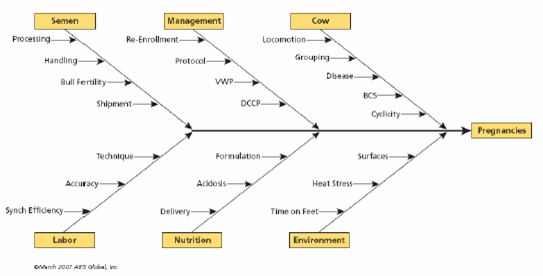 |
|
Figure 1. Reproductive Impact Flowchart
|
Below is a partial list of fundamental influencers of PR the author commonly finds on commercial dairy operations and the suggested compliance monitoring techniques:
- Postpartum health events - poor transition periods can influence the incidence of retained placenta, displaced abomasums, metritis and subsequently delay days to conception. Mastitis is similarly related to reduced fertility and increases the risk of abortion if pregnant (1, 9). Focusing on consistent ration delivery, dry matter intake and stable rumen health both pre- and post-partum are sound objectives to avoid excessive body condition loss and postpartum health events.
Monitor dry matter intake, stocking density, manure scores, cud chewing, post fresh body condition change, and milk production scatter graphs during early lactation. NEFA and BHBA sampling can also be utilized to debottleneck transition management.
- Insemination risk (IR) or getting semen in eligible animals represents the largest opportunity to improve PR on most commercial dairies today. IR for the first breeding should be monitored to ensure >95% of animals are inseminated within a desired breeding window of 25-30 days from the voluntary waiting period (VWP) as shown in Figure 2.
Monitor percent bred above and below the desired VWP window (ie. VWP +30 days) for the previous 90 days - less than 1-2 percent is an attainable goal at above and below the defined window.
 Figure 2. Scatter graph for monitoring IR both below VWP and above VWP + 30 days
Figure 2. Scatter graph for monitoring IR both below VWP and above VWP + 30 days
- Technician performance - time, temperature, and hygiene are the hallmarks of consistent technician performance. Accepted AI technique is to thaw semen for 45-60 seconds at 35- 37 degrees Celsius and accurately deposit in the body of the uterus within 15 minutes of removal from liquid nitrogen. In addition, it is highly suggested that semen tanks are secured with padlocks to limit access and contain thaw monitors to detect possible semen damage (Figures 3 and 4).
Monitor blood progesterone to determine accuracy of heat detection, maximal time from thawing to deposition in uterus, cleanliness, placement during annual refresher courses, and tank performance with thaw monitors. Technician CR should be evaluated using caution to avoid bias from season, binomial variation, parity, breeding type or service number.
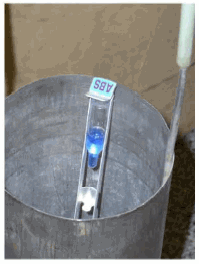

Figure 3. Semen Tank
Thaw Monitors in canisterFigure 4. Semen Tank
Thaw Monitors removed
- Cow observations and activity charting - multiple studies have shown high producing healthy cows should spend 12-14 hours per day lying comfortably. Recent research studies (Grant 2004) estimate each additional hour lying translates into 2-3.5 increased pounds of milk per day. In another study (7), researchers showed that animals will reduce eating activity in favor of resting activity when time allotments are restricted by daily management activities. Additionally, extended time standing and/or long distances in transit to parlors can increase locomotion scores which have been associated with decreased fertility and expression of heats (2). The author’s field experience indicate that extended time on feet is currently one of the largest limiting factors to achieving high production, reproduction, and long lived cows on commercial dairies today resulting from long holding times, overcrowding, or inadequate facilities.
Monitor lying index, turn times, lockup times, locomotion scores, and stocking density. Total time on feet can be estimated by utilizing a cow activity tool as shown in Figure 5.
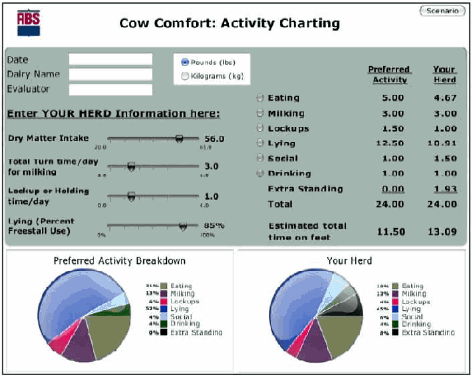 Figure 5. Activity Charting Dashboard to estimate total time on feet
Figure 5. Activity Charting Dashboard to estimate total time on feet
- Synchronization efficiency - although there is a wide range of synchronization protocols utilized within commercial dairies, the majority of commercial herds utilize a combination of both heat detection methods and synchronization to optimize IR and drive pregnancy production. Timed insemination (TAI) programs are designed to reduce heat detection errors, but concurrently introduce several variables including cyclicity, administration technique, drug storage and efficacy, and timing of injections that require routine monitoring. To optimize fertility, our current suggestion is that animals should not be inseminated before 50-55 days for detected heats or 70-80 days for timed inseminations.
Monitor synchronization efficiency and cyclicity of animals entering TAI programs using blood progesterone testing on 20+ animals at time of TAI and again (on same animals) 7-14 days post insemination. Goals are 90% or greater for both synchronization efficacy and cyclicity. TAI breedings should be coded to allow evaluation of performance in comparison to other insemination types.
- Re-enrollment of open animals - quickly returning open animals to the breeding pool improves PR. Resynch programs that ensure all open animals found on herdcheck are reinseminated within 10 days are optimal. In addition, extended herdcheck intervals and days carried calf at pregnancy check fundamentally increase the time until open animals may be detected which often present opportunities to improve PR.
Monitor days to rebreeding for all cows found open on herdcheck for last 30-60 days, herdcheck interval, and days since breeding when pregnancy determination is made. Pregnancy reconfirmation is also suggested at 100-120 days carried calf to assist management of animals that have experienced pregnancy loss.
- Heat stress - management has become more critical in recent years as milk production continually increases in commercial herds (USD-NASS 2004) resulting in higher intakes and BTUs produced by lactating animals. Wiltbank and coworkers showed reduced embryo quality of lactating animals compared to heifers during heat stress. Holding pens appear to be a major contributor to heat stress loads on many commercial dairy operations resulting in significant temperature spikes at milking that lead to decreased intakes, slug feeding, and potentials for early embryonic loss. Obviously, providing adequate sources of clean high quality water within pens and in transit from the milking parlor is fundamental to minimizing the above effects of heat stress.
In addition to monitoring respiration rates post milking, data loggers to record both animal and holding pen temperatures should be utilized to evaluate capacity and functionality of cooling systems (Figure 7).
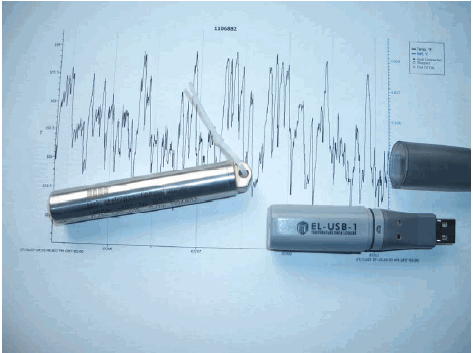 Figure 7. U-12 Stainless Internal (HOBO) and USB External Monitor with temperature tracing
Figure 7. U-12 Stainless Internal (HOBO) and USB External Monitor with temperature tracing
- Evaluation of insemination type - is an effective tool to highlight opportunities to improve reproductive performance. During data entry, different insemination types are assigned codes and subsequently compared for the same time period. Commonly used codes include natural or chalk, TAI, requested, dirty, blood, and others as applicable to specific reproductive programs. Note: When evaluating CR, it is suggested that a minimum of 250- 300 observations for each insemination type be evaluated to avoid making incorrect decisions due to normal binomial variation (Figure 6).
Monitor CR of various breeding types by establishing codes using caution to avoid bias from season, binomial variation, parity, technician, and service number.
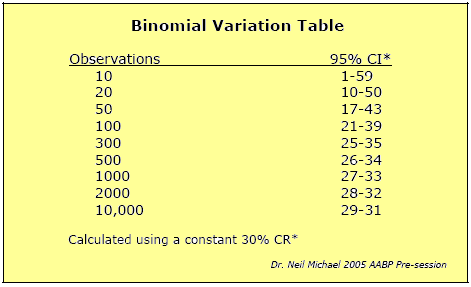 Figure 6. Binomial outcome table showing observations and expected confidence intervals
Figure 6. Binomial outcome table showing observations and expected confidence intervals
Summary
Achieving a consistently high rate of pregnancy production is profitable and achievable on commercial dairy operations through systematic evaluation of fundamental inputs to the production system. Improving fundamental processes including transition period, insemination risk, technician performance, activity charting, synchronization efficiency, re-enrollment of open animals, and heat abatement can contribute to increased pregnancy rates on many commercial dairies. Once optimized, establishing routine compliance monitoring programs to detect aberrations and drift in system are necessary to minimize variation.
References
- ABS Techline: Mastitis Impairs Reproductive Performance, ABS Technical Services, 2005, available at http://www.absglobal.com/tech_serv/resources/dairy/udderhealth.phtml
- ABS Techline: Poor Locomotion Impacts Reproductive Performance. 2007. Available at http://www.absglobal.com/tech_serv/resources/dairy/reproductivemanagement.phtml
- Albright, J.L. 1993 Feeding behavior in dairy cattle. J. Dairy Sci. 76:485.
- Dado, R.G., and M.S. Allen 1994. Variation in and relationships among feeding, chewing, and drinking variables for lactating dairy cows. J. Dairy Sci. 77:132-144.
- Fetrow, J., et al. Reproductive health programs for dairy herds: analysis of records for assessment of reproductive performance. Current Therapy in Large Animal Theriogenology. 2nd ed. 2007; 473-489.
- Grant, R.J., and J.L. Albright. Feeding behavior. In Farm Animal Metabolism and Nutrition. J.P.F. D’Mello, ed. CABI Publishing. New York, NY 2000.
- Metz, J.H.M. 1985. The reaction of cows to short term deprivation of lying. Appl. Animal Behavior Sci. 13:310.
- Niles, D. Using Pregnancy Rate to Monitor Reproductive Management. Proc. 2001 Tri-State Northwest Dairy Shortcourse 2001:61-68.
- Santos, J., et al. Transition cow management to reduce metabolic diseases and improve reproductive management. 2003 FL Dairy Production Conference Proceedings.
Further Reading
| - | You can view the 3rd Annual I-29 Dairy Conference listings by clicking here. |
February 2008

